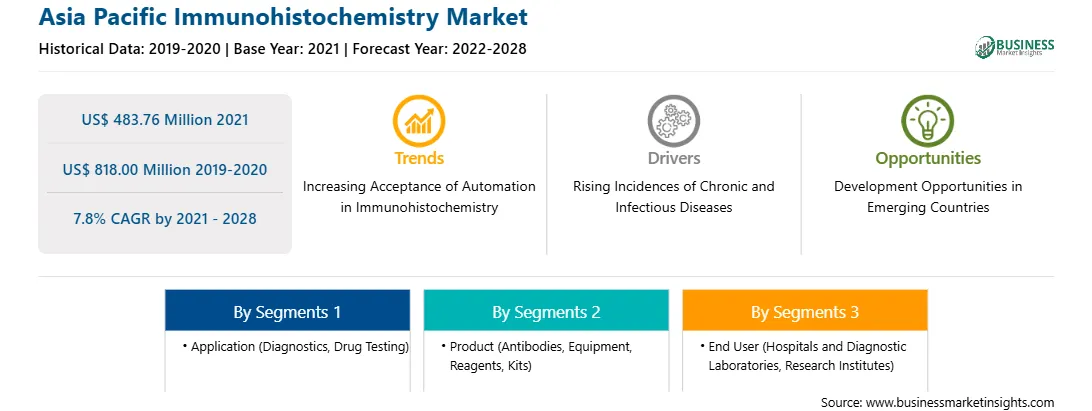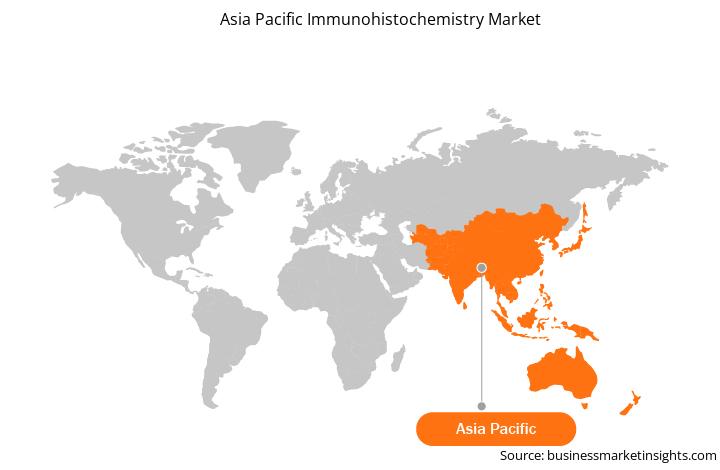APAC is the fastest-growing regional market for immunohistochemistry; and China, India, Japan, South Korea, Australia, and Rest of APAC are the major contributors to the market in this region. China led the market in 2021. The market's growth is attributed to the increasing R&D activities, rising investments in the healthcare sector in developing countries, and increasing collaborations between regulatory outsourcing and drug developers. The market players are launching products. For instance, in August 2020, Gilead Sciences Inc. received approval for Truvada, an HIV prevention for use in adults and adolescents medicine in China. This approval will help in preventing HIV among the healthy population. Numerous infectious diseases are emerging, re-emerging, or causing recurrent outbreaks in Asia and the Pacific region. People traveling more frequently, living in more densely populated areas, and coming into closer contact with wild animals, have increased the potential for emerging infectious diseases to spread rapidly. The current COVID-19 situation has also increased the surveillance of the influenza virus among the population to improve the diagnosis of the disease. According to the National Health Commission (NHC) of China, there were a total of 81,285 coronavirus-infected cases reported in China by March 26th, 2020, with a total number of 3,287 deaths due to the virus outbreak. The disease was transmitted at a rapid pace in the initial phases. However, the prevalence of diseases due to different viral infections such as the Rotavirus viral, Hepatitis A-E virus, Dengue virus, and others are also expected to drive the market in the forecast period. This, rising remerging infectious diseases, improving diagnostic capabilities, and rise in government programs regarding the better understanding of viral diseases are expected to drive Immunohistochemistry market growth in coming years.
Countries in APAC, especially India, are highly affected due to the COVID-19 outbreak. The supply chain disturbances and the tremendous demand for efficient treatments for the therapy of COVID-19 have put the healthcare research industry in a crucial situation in APAC. Prohibitive measures have been taken to control the spread of the novel coronavirus. The COVID-19 pandemic has adversely affected economies in the region. The socioeconomics was severely affected, rising in negative inflation, GDPs, and a regional unemployment surge. Countries, such as China, Japan, Singapore, and South Korea, are seeing an increased interest in clinical trials. High costs in western countries are also contributing to the flow of medical affairs outsourcing to APAC. To expand sales to the Asian market, pharmaceutical companies are becoming aware of new and changing regulatory environments for drugs, devices, and in-vitro diagnostics. New or improved regulations are implemented frequently in Asia, including changes in GMP standards, drug price controls, and medical device regulatory systems. Third-party guidance and advice are required as a part of any acquisition or any improvement of current standards. Increasingly, third-party outsourcing service providers are playing a significant role in supporting the associated market in APAC. However, the market has stabilized compared to the initial phases of the pandemic owing to the control procedures, awareness among people, vaccination availability, and supportive government policies of the business in the related market.

Strategic insights for the Asia Pacific Immunohistochemistry provides data-driven analysis of the industry landscape, including current trends, key players, and regional nuances. These insights offer actionable recommendations, enabling readers to differentiate themselves from competitors by identifying untapped segments or developing unique value propositions. Leveraging data analytics, these insights help industry players anticipate the market shifts, whether investors, manufacturers, or other stakeholders. A future-oriented perspective is essential, helping stakeholders anticipate market shifts and position themselves for long-term success in this dynamic region. Ultimately, effective strategic insights empower readers to make informed decisions that drive profitability and achieve their business objectives within the market.

| Report Attribute | Details |
|---|---|
| Market size in 2021 | US$ 483.76 Million |
| Market Size by 2028 | US$ 818.00 Million |
| Global CAGR (2021 - 2028) | 7.8% |
| Historical Data | 2019-2020 |
| Forecast period | 2022-2028 |
| Segments Covered |
By Application
|
| Regions and Countries Covered | Asia-Pacific
|
| Market leaders and key company profiles |
The geographic scope of the Asia Pacific Immunohistochemistry refers to the specific areas in which a business operates and competes. Understanding local distinctions, such as diverse consumer preferences (e.g., demand for specific plug types or battery backup durations), varying economic conditions, and regulatory environments, is crucial for tailoring strategies to specific markets. Businesses can expand their reach by identifying underserved areas or adapting their offerings to meet local demands. A clear market focus allows for more effective resource allocation, targeted marketing campaigns, and better positioning against local competitors, ultimately driving growth in those targeted areas.

The APAC immunohistochemistry market is expected to grow from US$ 483.76 million in 2021 to US$ 818.00 million by 2028; it is estimated to grow at a CAGR of 7.8% from 2021 to 2028. Immunohistochemistry (IHC) refers to an important application monoclonal and polyclonal antibody for tissue determination and distribution of antigens of particular disease. It is majorly used to detect several infectious disorders like dengue, hepatitis, human immunodeficiency virus (HIV). Chronic medical conditions such as obesity, cancer, diabetes, heart disease, and stroke, are also considered to be the primary major applications of immunohistochemistry that helps in the diagnosis of these diseases. Diabetes is prevailing at a high rate in the geriatric population across the region. The prevalence of diabetes is more in overweight and obese people. The obesity rates have been increasing rapidly in developed as well as developing economies across the region. Factors such as unhealthy lifestyle and sedentary life are among the major for the rise in the number of obese individuals. Cardiovascular diseases (CVDs) include cerebrovascular disease, rheumatic heart disease, coronary heart disease, and other conditions. It is the most significant cause of morbidity and mortality across the region. Furthermore, there has been a rise in cancer incidence and mortality rates all over the region, making cancer the leading cause of death. Such an increase in the incidence of chronic and infectious diseases is expected to create a demand for immunoassay tests around the APAC region.
In terms of product, the antibodies segment accounted for the largest share of the APAC immunohistochemistry market in 2020. In terms of application, the diagnostics segment held a larger market share of the APAC immunohistochemistry market in 2020. Further, the hospitals and diagnostic laboratories segment held a larger share of the APAC immunohistochemistry market based on end user in 2020.
A few major primary and secondary sources referred to for preparing this report on the APAC immunohistochemistry market are company websites, annual reports, financial reports, national government documents, and statistical database, among others. Major companies listed in the report are Abcam plc; Agilent Technologies, Inc.; Bio SB; BIO-RAD LABORATORIES INC.; Cell Signaling Technology, Inc.; Danaher; F. HOFFMANN-LA ROCHE LTD.; MERCK KGaA; PerkinElmer Inc.; and THERMO FISHER SCIENTIFIC INC.
The Asia Pacific Immunohistochemistry Market is valued at US$ 483.76 Million in 2021, it is projected to reach US$ 818.00 Million by 2028.
As per our report Asia Pacific Immunohistochemistry Market, the market size is valued at US$ 483.76 Million in 2021, projecting it to reach US$ 818.00 Million by 2028. This translates to a CAGR of approximately 7.8% during the forecast period.
The Asia Pacific Immunohistochemistry Market report typically cover these key segments-
The historic period, base year, and forecast period can vary slightly depending on the specific market research report. However, for the Asia Pacific Immunohistochemistry Market report:
The Asia Pacific Immunohistochemistry Market is populated by several key players, each contributing to its growth and innovation. Some of the major players include:
The Asia Pacific Immunohistochemistry Market report is valuable for diverse stakeholders, including:
Essentially, anyone involved in or considering involvement in the Asia Pacific Immunohistochemistry Market value chain can benefit from the information contained in a comprehensive market report.